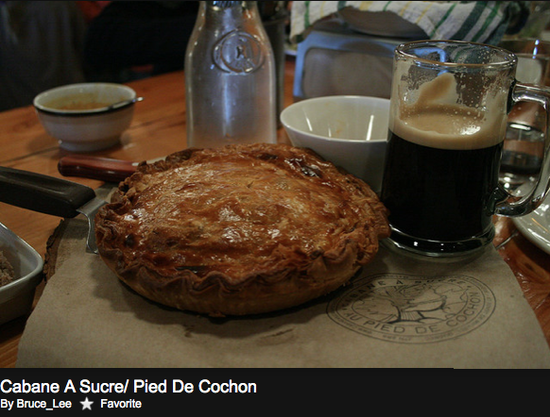Sugarhouses in Quebec's Hinterland
Ji Jia Ying
 From late February
to early May, perhaps the best known activity in Quebec is eating hot maple
taffy off fresh snow, which is made by a cabane
à sucre. Cabane à sucre are
Quebecor sugarhouses, which most of the time are family owned. Usually, you can
find one less than a day's trip out of Montreal. The old backwoods, warm environs are the reason that tourists from everywhere in
the world and the Quebecor families go to the small, authentic sugar shacks every
winter. There are hundreds of sugarhouses in Quebec. Many families and guests
gather together to celebrate and enjoy the sweet treats that are offered.
From late February
to early May, perhaps the best known activity in Quebec is eating hot maple
taffy off fresh snow, which is made by a cabane
à sucre. Cabane à sucre are
Quebecor sugarhouses, which most of the time are family owned. Usually, you can
find one less than a day's trip out of Montreal. The old backwoods, warm environs are the reason that tourists from everywhere in
the world and the Quebecor families go to the small, authentic sugar shacks every
winter. There are hundreds of sugarhouses in Quebec. Many families and guests
gather together to celebrate and enjoy the sweet treats that are offered.
My first experience at a cabane à sucre was with a group of Concordia students. The sugarhouse keepers were very warm and kind to us. They not only provided a tour of their sugarhouse but also prepared lots of delicious food. Traditional cabane à sucre cuisine is rich in ham, bacon, sausages, eggs and pork rinds. In addition, many operators have begun varying their menus to satisfy target markets such as vegetarians, Muslims and Jews. Many varieties of dishes with maple syrup and breakfast type dishes were served. After dinner, there were many outdoor activities. We rode on sleighs, visited maple woods and learned how to make maple syrup.
Maple syrup is a one kind of
syrup made from the sap of sugar maple, red maple or black maple trees. Sugar makers drill a small hole into
the trunk, collect the sap from maple trees and then boil it down to maple
syrup inside the sugarhouse. On our trip, the most popular activity was making maple
syrup taffy.
Firstly, sugar makers poured hot maple syrup in a line on a patch of clean snow. After a few seconds, we rolled maple syrup taffy around sticks. After just a few seconds, it was ready to eat. There was also a sugarhouse shop, which sold all kinds of fresh maple syrup products that we purchased as gifts before leaving.
In
Canadian culture,
sugar shack fare is warm, bringing us back to a time when winter
survival was a
serious obstacle. It was a very important nutritional source at the
time. Maple syrup is a healthy sustainable food product. Pure maple
syrup
has no fat and is a good source of manganese and zinc. Compared to honey, maple syrup
has 15 times more calcium and 1/10 as much sodium. Finally, this festival brings
excitement after the long and boring winter season.
This festival is special to Canadians because it symbolizes the end of winter and the longing for summer. When you go to sugarhouses, you can automatically read the happiness and energy on everyone's faces. Finally, the most important thing is that maple syrup has cultural significance. During the American civil war and World War II, Maple syrup was one of the main sources of energy and nutrition for soldiers. This is partly the reason why maple leaves represent Canada. It is well known that the red maple leaves are the symbol of independence, unity and dignity in Canada.
Cabane à sucre is not just business as usual but a bridge to help people learn
about Canadian traditions. After my trip, I remember most the Canadians' warm
anticipation of the end of the cold winter. Till this day, I still miss the
kindness of the people and their tasty sugar treats.
An Assortment of Sugarhouses
- La Cabane à Sucre
Millette Sugar Shack Inc, Mt-Tremblant, Laurentides, Québec
- Cabane á Sucre Chez Dany, 195 rue de la Sabliére, Trois-Riviéres Quebec
- Cabane á Sucre Du-Bois-é, 1670 rue Louis de France, Trois-Riviéres Quebec
- Sucerie de la Montagne, 300, Chemin St-Georges, CP 1540, Rigaud, Quebec
- Au
Gré des Saisons, 288, Rang Ste-Germaine, Oka, Quebec
- Chalet des Érables, 384, Montée Gagnon (Route 335) Sainte-Anne-des-Plaines Quebec
- Cabane á Sucre D'Amours, 427 5e Avenue, Ste-Anne-des-Plaines, Quebec
- Cabane á Sucre au Pied du
Cochon- operated by Philippe Poitras, Martin Picard and Marc Beaudin,
11382, rang de la Fresnière, St-Benoît, J7N 2R9
Leave a comment